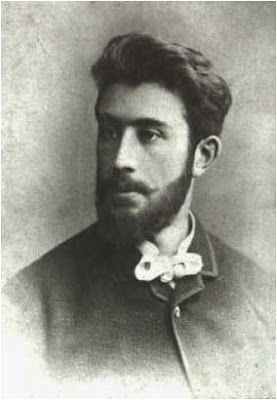 |
| Gigo Gabashvili's painting The Bazaar in Samarkand. He painted four versions of this bazaar in front of the Sher-Dor Madrasah in Samarkand's Registan Square |
Although not widely known in the West, Gabashvili's paintings are highly valued - the artist's late 19th century painting The Bazaar in Samarkand, sold for $1.36 million US dollars at Christie's in 2006.
His 1894 visit to Turkestan, as Central Asia was then known, was triggered by a visit to Tbilisi by a wealthy American businessman, Charles Crane. Crane was heir to a large industrial fortune, a connoisseur of Arab culture and a noted Arabist.
Crane liked Gabashvili's works and commissioned several paintings on the Caucasus as well as two paintings of Samarkand and Bukhara. When Gabashvili arrived in Central Asia he was captivated by the light, the monuments, the daily life of the people and their customs. He filled his sketch books with hundreds of drawings and studies.
 |
| Gigo Gabashvili in 1885 |
After Central Asia, Gabshvili went to Munich to further his studies. While there he continued to draw on his Central Asian experiences. According to art historian Grigol Beradze, he worked on paintings of Samarkand and Bukhara, which were exhibited in Munich's Kunstverein and Glaspalast in 1895, drawing favourable reactions. It was these paintings, after the Munich exhibitions, that were dispatched to Charles Crane.
Gabshvili stayed in Munich until 1897, after which he returned to Tbilisi) and devoted the latter part of his life to teaching, and founded an art studio. From 1900, he taught at the school of drawing at the Caucasian Society for the Promotion of the Arts, where he later became director. From 1922 to 1930 Gabashvili was the head of the art studio at the Academy of Art in Tbilisi .
It was with much joy that I discovered this painter and the connection with Uzbekistan on a recent visit to Georgia. You can view some of his works at Georgia's Museum of Fine Arts and the Georgian Art Palace Museum, as well as two other paintings below.
Related posts:
Georgian State Silk Museum
Georgian painter Levan Lagidze's London exhibition: Bach Exercises
Robert Rauschenberg: Samarkand Stitches
Ernst Neizvestny's Last Soviet Sculpture - Ashgabat, Turkmenistan
 |
| Gigo Gabashvili's painting Pilgrims from Samarkand |
 |
| Gigo Gabashvili's painting Divan Begi, Bukhara (known today as Lyabi Haus) |